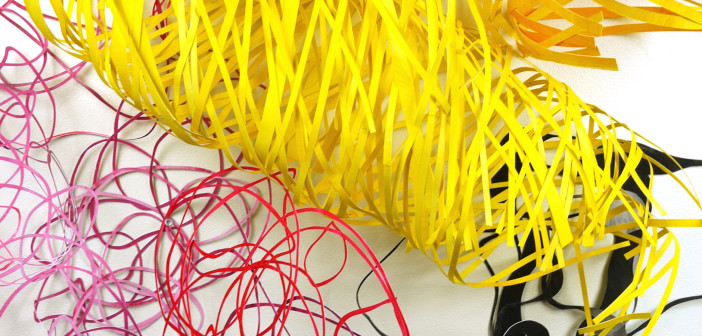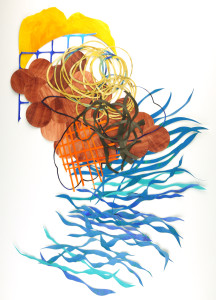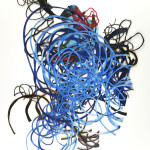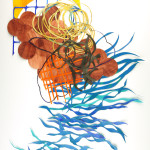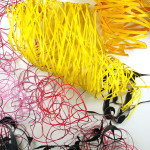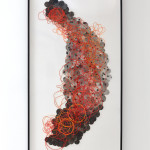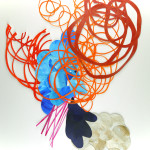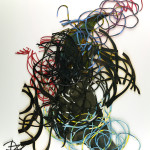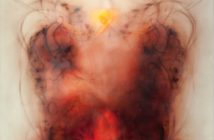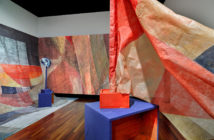Paper is the surface, the substrate, the thing acted upon. It buckles (sometimes literally) under the weight of an artist’s wishes, absorbing paint, water, ink, paste. Though it groans with the occasional curl, crease or tear, paper is usually cooperative, and open to experiment. Barbara “Babs” Owen gives pulp new purpose in her latest solo show, Paper is the Material, on view through November 14 at Hunter Gallery in Middletown, RI.
The exhibit is a concise survey of Owen’s work from the past two and a half years. The titular material is cut paper, stained with ink and painted acrylic and configured into lively abstractions. The Pawtucket-based artist arrived at this method through her earlier ventures in shape-driven abstract painting, specifically the series Bloom, which Owen calls a “breakthrough…[They were the] first paintings that were absolutely from me.” Owen would cut shapes from paper, using them to plot preliminary drawings on canvas.
The detritus of that series eventually coalesced into the work now on view at Hunter, the teaching gallery for Saint George’s School. Owen displays one of her "cut ups" on a pedestal, inviting students to touch and interact with her materials. This show-and-tell signals the importance of physicality in Owen’s work, reflected in the show’s title, with its focus on material.
Owen’s method of cutting is loudly and compellingly illustrated by an untitled installation—colored, julienned strips of paper wobbling, waving and curvaceous, airy structures gliding across the wall. She constellates the strips onsite, so the arrangement is always unique. The presentation at Hunter is a chromatic invasion of the gallery space. A yellow cyclone headbutts an orange whirlwind, colliding with a huge, jumbling mass of red. Below, syrupy trails of black sneak away. A large blue entity is removed from the action, confined to the corner, observing from afar. Shadows dart from beneath the shapes.
“[I’m] further abstracting the abstraction, and getting farther away from the initial language making of shapes,” she says. “Further abstraction” can be a code word for lack of feeling or forethought, but one senses neither of these shortcomings in Owen’s work. She’s a formalist, but not an undead one. The color, playfulness, and corporeality of her cut ups distinguishes her from the much-discussed trend of zombie formalism.
Her installations are impressively spatial, their visual bedlam suggesting a momentary burst of energy. One can imagine the pieces conquering an entire room, pooling together, cascading from the ceiling and walls, shooting up from the floor. An earlier show at the Grimshaw-Gudewicz Gallery in Fall River, Mass., enlightened Owen to the potential massiveness of the installations. It would be thrilling to see them taken to a more immersive level, toward a Dionysian explosion of line and shape. “I haven’t figured out the stuff on the wall,” Owen says, noting there is “still a lot of growth” possible.
While the gallery layout implied Owen was moving from constraint into chaos, from tiny framed pieces to climactic installations, the artist says she’s “trying to get back to painting,” and thus a return to the canvas or, at least, a picture plane. The framed pieces are her most recent efforts. In Cut ups XX, Owen combines grids, fat squiggles of blue, rings of gold, and a cloud of brown circles. Line and shape morph and blend freely with one another, mutating toward gesture. Double-sided cut ups cast colored silhouettes, an extremely subtle but pleasant detail.
Owen cites the newest cut ups as “illustrative…I’m really trying to draw.” If line is the essence of drawing, and color the core of painting, Owen attempts peacemaking between the two practices. These efforts recall Cy Twombly’s scribbles, a purely formal comparison. Owen’s work looks too jubilant to be heavily indebted to Twombly. Her use of line feels organic and painterly, freed from the flatness of a sheet of paper, lacking the violence of a series like Twombly’s Fifty Days at Iliam. But Twombly and Owen carve through space similarly, with kinetic lines ricocheting, seemingly of their own accord.
“Cutting paper from a painter’s point of view takes you into another realm,” Owen says. With the cut ups, she can achieve “sharp boundaries” between colors, an aesthetic she admires in the work of painter Amy Sillman. “I’m doing that with the paper very easily.”
Owen contributes to a “conversation about how paint is applied,” a dialogue Sillman also engages. Her paintings have invoked comparisons to Looney Tunes, sight gags and “queer formalism.” Her canvases often feature peculiar shapes, sharp areas of color, and splashes of figuration blurred seamlessly with abstraction. Sillman works within the wake of abstract expressionism, “not undoing but redoing [it]” she explains in a 2011 article. “As we pass into a time when pencil smudges themselves are an increasingly exoticized thing of the past, the world is still tactile and material. To touch it is to know it.”
Echoing Susan Sontag’s formalist credo a half-century ago, Sillman said in a 2006 interview, “Content is part of form and form is part of content.” Owen’s work occurs within this dialogue, and she gleefully discusses her measured, thoughtful methods. Her work’s expressiveness relays an acute understanding of process and material; these attributes are the primary content of her work.
Owen’s preoccupation with form is refreshing. If she abandoned the cut ups entirely, the physicality of paint and the realness of line would likely remain in her work. Owen’s body of work thrives on the body of abstraction. The undeniably physical cut ups are perhaps most effective, but one suspects Owen’s future paintings will pursue the same concerns.
“The paper brought me back to that really pure way of painting,” she says, one that incorporates both “abandon” and “planning.” Owen is sculpting with paper, drawing with line and painting with space. Her work coincides with a reemerging interest in painting as a material practice. MoMA’s 2014 survey of ultra-contemporary painting, The Forever Now, evinced “the ebullience of secular art freed of any ideological task,” wrote David Salle for ArtNews. He praised the stronger painters (Sillman among them) for “formal inventiveness and pictorial intelligence…Not having to spend so much energy defending one’s decision to paint has given painters the freedom to think about what painting can be.”
Owen falls within this category of painters reclaiming paint. “It’s like painting has to have an alibi,” Sillman said in 2006. These artists realize that conceptual rigor is not a demand for contemporary painting, and inquiries into the physical and formal nature of paint can be as intellectually satisfying as they are visually appealing.
Painting is “still a mystery” for Owen, and this sense of enigma lingers in her work. Her cut ups possess a spectacular presence, as evidenced by a large, commanding piece like Black Sumac. Its warm lines mesmerizingly curve, collapse, melt and merge, throwing heat against an apathetically cool background of gray circles. These eruptions sway the viewer to reconsider space and form, as two dimensions mingle with three. Off the wall or under glass, Owen’s abstractions embody formal concerns with vitalizing success.
- Babs Owen, “Untitled (cut ups V)” 2015, ink and acrylic on paper, 30h x 24 w inches
- Babs Owen, “Untitled (cut ups XX)” 2015, ink and acrylic on paper, 30h x 24 w inches
- Babs Owen, “Hunter”, 2015, ink and acrylic on paper
- Babs Owen, “Black Sumac” 2015, ink and acrylic on paper, 85h x 43w inches
- Babs Owen, “Untitled (cut ups XXI)” 2015, ink and acrylic on paper, 30h x 24 w inches
- Babs Owen “Untitled (cut ups XII)” 2015, ink and acrylic on paper, 30h x 24 w inches
All images courtesy of the artist.

